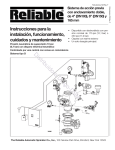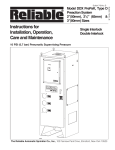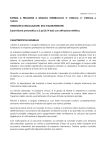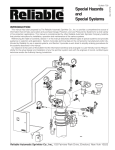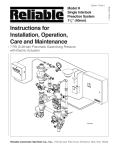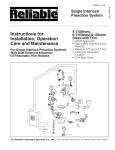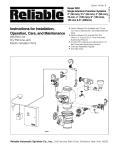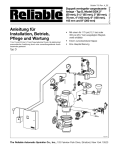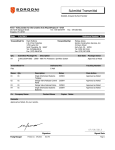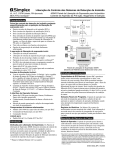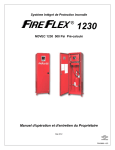Download Reliable Single Interlock Preaction System Instruction manual
Transcript
Bulletin 727 Rev. G
Instructions for
Installation, Operation,
Care and Maintenance
•
•
•
Bulletin 727 Rev. G
Single Interlock
Preaction System
4” (100mm), 6” (150mm)
& 165mm Sizes
Available with 175 psi (12,1 bar) or
250 psi (17,2 bar) Rated Solenoid
Valve
Externally Resettable Clapper
One Main Drain
2 PSI (0,14 bar) Pneumatic Supervising
Pressure with Electric Actuation
The Reliable Automatic Sprinkler Co., Inc., 103 Fairview Park Drive, Elmsford, New York 10523
General Description
• A trouble annunciator signals whenever the integrity
Single Interlock Preaction Systems are designed for water-sensitive areas that require protection from inadvertent
water flow into the sprinkler system piping.
Sprinkler piping in single interlock systems can effectively
be supervised by means of a Reliable Model B Air Compressor Panel or Model C Pressure Maintenance Device. Loss
of 2 psi (0,14 bar) supervising pneumatic pressure, due to
a damaged sprinkler or sprinkler pipe will not cause water
to flow through the Model DDX Deluge Valve and into the
system piping. A significant loss of pneumatic pressure
will activate a trouble-annunciating device when the system
pressure falls below 0.7 psi (0,05 bar).
When one electrical detector senses the presence of fire,
the electrical releasing control panel activates fire alarm devices and latches the normally-closed solenoid valve (175
psi (12,1 bar) or 250 psi (17,2 bar) Rated) in the open position (Note: Arranging detectors in a cross-zoned pattern will
require operation of two detectors before the solenoid valve
can open). The solenoid valve, when closed, retains sufficient water pressure in the pushrod chamber of the Model
DDX Deluge Valve to maintain it closed. Energizing the solenoid valve relieves the water pressure, thus opening the
Deluge Valve and allowing water to flow into the sprinkler
system.
To fully operate a cross-zoned single interlock system, two
electrical detectors must activate and a sprinkler head must
open. During the early stages of a fire, smoke or heat activates the first detector, which causes the control panel to
produce a local alarm and an alarm at the main fire alarm
panel. Electrical relays inside the releasing control panel
can be used to shut down air moving equipment or activate
security doors and other electrical devices when the panel
goes into the first alarm condition. Subsequent activation of
a second, nearby or adjacent, detector will cause the panel
to energize the solenoid valve open and release water into
the sprinkler system piping. Water flowing into the sprinkler
system piping will simultaneously produce water pressure
that causes the transfer of contacts in the pressure switch
mounted in the Reliable Single Interlock Preaction System’s
riser assembly. This pressure switch can electrically initiate
the shutdown or startup of equipment, such as computers or
other second alarm devices. The flow of water into the sprinkler system piping effectively converts the dry system into a
wet pipe system. In the event that the fire subsequently produces sufficient heat to operate a sprinkler head, water will
flow from that sprinkler, controlling or suppressing the fire.
The major benefits of a single interlock preaction system,
when compared with a wet pipe (deluge) system are as follows:
of the piping or sprinklers is accidentally or intentionally disturbed; however, no water flow or water damage will occur at that time.
• Speedy detection and an early fire alarm are pro-
vided by fire detectors, without the delay associated
with water delivery time in the event of a fire. Note
that with a wet pipe system, the fire alarm is delayed
until after water has begun flowing from an operated
sprinkler head.
At the heart of Reliable’s Single Interlock Preaction System is the Model DDX Deluge Valve. This Deluge Valve is a
hydraulically operated, straight-through-design, differentialtype valve (see Fig. 1). System maintenance is simplified
since priming water is not required and the Deluge Valve
can be reset externally without cover removal. This is accomplished by pushing in and turning the external reset
knob at the rear of the Deluge Valve (see Fig. 1). This feature
provides a significant system-restoration time advantage.
The Reliable Single Interlock Preaction System trim set (see
Fig. 2) provides all of the necessary equipment for connections to the Model DDX Deluge Valve’s pushrod chamber
inlet and outlet ports, the 2” (50mm) main drain, alarm devices, air supply, water supply, and required pressure gauges.
This trim set is available in individual parts, in time-saving,
segmentally assembled kit forms, or fully assembled to the
Model DDX Deluge Valve (with or without a control valve).
Listings & Approvals
Reliable 4” (100mm), 6”(150mm) and 165mm Single Interlock Preaction Systems are Underwriters Laboratories, Inc.
Listed and UL certified for Canada (cULus) in the Special
System Water Control Valves – Deluge Type (VLFT) category.
Reliable 4” (100mm), 6”(150mm) and 165mm Single Interlock Preaction Systems are certified by Factory Mutual
Approvals (FM). Factory Mutual does not approve the use
of smoke detectors or cross-zoned detectors in preaction
systems.
The NYC acceptance number for this system is MEA 25893-E.
Reliable Single Interlock Preaction Systems are UL Listed
and FM Approved only when used with the trim components
shown in Fig. 2.
• A fire alarm sounds prior to the operation of a sprin-
kler head, which may enable extinguishing the fire by
handheld means before the actual operation of any
sprinklers and subsequent water damage.
2.
3.
Fig. 1
4.
Fig. 2
Single Interlock Electric Release Preaction Trim Parts List (Refer to Fig. 2)
Item
No.
Part No.
6103060024
1
6103040026
6215052400
2
6215051600
7g05242400
3
7g05161600
7d05464200
4
7d05444200
98048028
5
98048025
6
7
8
9
10
11
12
13
14
15
16
17
18
19
20
21
22
23
24
25
26
27
28
29
30
31
32
33
34
35
36
37
38
39
40
41
42
6871010000
6871020020
78653000
78653004
78653100
92056702
92056703
92056810
92056704
92056705
94616917
96606601
96606607
96606612
96606627
96920912
98048015
98048022
98048025
98050004
98174401
98174402
98174403
98174404
98174405
98248000
98248001
98543208
98543209
98543210
98543213
98543220
98543222
98543223
98543226
98543228
98543230
98543237
Description
Assembly, Valve, 6” (150mm)
For 6” Ass’y Only
Assembly, Valve, 4” (100mm
For 4” Ass’y Only
Wafer-butterfly Valve, 6”
For 6” Ass’y Only
Wafer-butterfly Valve, 4”
For 4” Ass’y Only
Coupling, Rigid, 6”
For 6” Ass’y Only
Coupling, Rigid, 4”
For 4” Ass’y Only
Coupling, 6” Grooved W/ 1” Npt Outlet
For 6” Ass’y Only
Coupling, 4” Grooved W/ 3/4” Npt Outlet
For 4” Ass’y Only
Bushing Reducer, 1” X 1/4”, Galv.
For 6” Ass’y Only
Bushing Reducer, 3/4” X 1/4”, Galv.
For 4” Ass’y Only
Valve, Solenoid (175 Psi) 175 Psi Rated
Valve, Solenoid (250 Psi) 250 Psi Rated
Assembly, Manual Emergency Station
Assembly, Valve Caution Station, 1/2”
Valve, Ball Drip, 1/2”
Connector, 3/8” Tubing X 1/4” Npt
Elbow, Male, 3/8” Tube X 1/4” Npt
Connector, 3/8” ID Tube X 1/2” Npt
Connector, Elbow, 3/8” ID Tube X 1/2” Npt
Connector, Elbow, 3/8” ID Tube X 1/4” Npt
Nameplate, Single Interlock
Tee, Glvn., 3/4”
Tee, Glvn., 1/2” X 1/2” X 1/4”
Tee, Glvn., 3/4” X 1/2” X 1/2”
Tee, Glvn, 2” X 2” X 1”
Flex Line, 12”
Bushing, Reducer, 2” Spigot X 1” Nptf, Pvc
Bushing, Reducer, 3/4” X 1/2”, Galv.
Bushing, Reducer, 3/4” X 1/4”, Galv.
Drain Cup, Pvc
Ell, 1/2”, Mall Iron, Galv.
Ell, 3/4”, Mall Iron, Galv.
Ell, 1”, Mall Iron, Galv.
Ell, 1/4”, Mall Iron, Galv.
Ell, 2”, Mall Iron, Galv.
Gauge, Air Pressure (0-80 Psi)
Gauge, Water Pressure (0-300 Psi)
Nipple, Steel, Galv., 2” X 3”
Nipple, Steel, Galv., 1/2” X 2”
Nipple, Steel, Galv., 1/2” X 2-1/2”
Nipple, Steel, Galv., 1” X Close
Nipple, Steel, Galv., 1/4” X 3”
Nipple, Steel, Galv., 1” X 3-1/2”
Nipple, Steel, Galv., 1/2” X 1-1/2”
Nipple, Steel, Galv., 1/4” X 1-1/2”
Nipple, Steel, Galv., 1/2” X 4-1/2”
Nipple, Steel, Galv., 1/2” X 3”
Nipple, Steel, Galv., 1/2” X 8”
Qty.
1
1
1
1
1
1
1
1
1
1
1
1
1
1
1
1
1
1
1
1
1
1
1
1
1
2
1
1
1
1
2
2
2
1
1
2
1
10
2
1
2
1
Item
No.
Part No.
43
44
45
46
47
48
49
50
51
52
53
54
55
56
57
58
59
60
61
62
63
64
65
66
67
68
69
98543238
98543244
98543266
98543279
98604406
98614401
98614403
98727607
98750003
98761649
98761651
98815200
98815204
98840100
98840117
98840145
98840147
98840160
98840171
98840172
98840181
98840187
99080002
89141112
----96686756
98768008
Description
Nipple, Steel, Galv., 2” X Close
Nipple, Steel, Galv., 1/4” X 2”
Nipple, Steel, Galv., 1” X 6”
Nipple, Steel, Galv., 3/4” X Close
Plug, Iron, Sq. Hd., 1/2”
Plug, Iron, Sq. Hd., 3/4”
Plug, Iron, Sq. Hd., 1/4”
Strainer, 1/4”
Pipe Cross, 1/2”, Galv.
Tee, Glvn., 1/2” X 1/4” X 1/2”
Tee, Glvn., 1/2”
Union, 1/2”, Iron, Galv.
Union, “O” Ring Seal, Galv., 1/2”
Valve, Angle, 2”
Valve, Ball, 1/4” Nptf X 1/4” Nptm
Swing Check Valve, 1” Npt
Check Valve, 1/4” Npt, Poppet Type Inline
Valve, 3-way, 1/4”
Valve, Globe, 1/2”
Globe Valve, 1/4”
Horiz. Swing Check Valve, 1/2” Npt
Valve, Check, 1/4” Nptf X 1/4” Nptm
Pad-adhesive
Tie, Retaining
----Tubing, Pvc, 3/8” ID X 6 Ft.
Copper Tubing, 3/8”
System Operation
Qty.
1
1
1
3
1
2
3
1
1
1
1
2
1
1
1
1
1
3
1
1
1
1
1
9
-1
30”
To fully operate a Single Interlock Preaction System, two
independent events must coexist before water flow will occur. One electrical detector (two detectors in a cross-zoned
system) must activate and a sprinkler head must open. Operation of either one of these items will only cause an alarm
to annunciate, but will not cause water to discharge from the
sprinkler system piping.
When set correctly for service, the Model DDX Deluge
Valve is hydraulically established to withhold the supply
water from the sprinkler system piping. The Reliable Model
DDX Deluge Valve is shown in both the closed and open
positions in Fig.1. In the closed position, the supply pressure acts on the underside of the clapper and also on the
push rod through the push rod chamber’s inlet restriction.
The resultant force due to the supply pressure acting on the
push rod is multiplied by the mechanical advantage of the
lever and is more than sufficient to hold the clapper closed
against normal supply pressure surges.
When a fire is detected, the energized solenoid valve vents
the push rod chamber to atmosphere through the chamber’s
outlet. Since the pressure cannot be replenished through
the inlet restriction as rapidly as it is vented, the push rod
chamber pressure falls instantaneously. When the push rod
chamber pressure approaches approximately one-third of
the supply pressure, the upward force of the supply pressure acting beneath the clapper overcomes the lever-applied force thereby opening the clapper.
5.
Once the clapper has opened, the lever acts as a latch,
preventing the clapper from returning to the closed position. Water from the supply flows through the Deluge Valve
into the system piping. Water also flows through the Deluge
Valve alarm outlet to the alarm devices.
After system shutdown, resetting the Model DDX Deluge
Valve is quite simple. Doing so only requires pushing in and
turning the reset knob at the rear of the valve (see Fig.1).
The external reset feature of the Model DDX Deluge Valve
provides a means for simple, economical system testing,
which is one essential facet of a good maintenance program. The external reset feature does not, however, eliminate another important facet of good maintenance, namely,
periodic cleaning and inspection of the internal valve parts.
In the event that water builds up inside the valve due to
condensate from the air supply system or water left inside
from valve system testing, a drain is available for venting.
After closing the main supply valve, a small valve over the
drain cup can be opened slightly until the water inside the
valve body and the main pipe column has drained. See
the section titled “Draining Excess/Condensate Water From
System” in this bulletin for the detailed procedure.
The Model B Manual Emergency Station (see Fig. 3) is also
included in the Reliable Single Interlock Preaction System
trim set. It consists of an aluminum nameplate mechanically
attached to a ball valve. The valve handle in its OFF position is guarded against accidental turning to the ON position
(and system discharge) by a nylon cable tie provided with
each trim kit. The cable tie is inserted, as shown in Fig. 3,
after the system has been restored for operation. The nylon cable tie is designed to allow, in case of an emergency,
forceful turning of the valve handle to the ON position. As
an alternative to the Model B Hydraulic Manual Emergency
Station, the Model A Hydraulic Manual Emergency Pull Box
(see Reliable Bulletin 506) is also available and can be provided as an option.
Whenever ambient temperature conditions are high, the
water temperature in the Model DDX Deluge Valve’s pushrod chamber could possibly increase, thereby increasing
the pressure in the chamber to values exceeding the rated
pressure of the system. In an indoor installation where standard room temperatures are exceeded, a pressure relief kit
may be needed. Pressure relief kit, P/N 6503050001, can be
installed into the pushrod chamber’s releasing line to limit
the pressure to 175 psi (12,1 bar).
a. Using a tapped connection directly below or next
to the main water supply control valve using a
welded outlet or the appropriate mechanical fittings. A grooved-end outlet coupling is one way
to achieve this (see Fig. 2); or
b. Using a water supply control valve that has an
available threaded (NPT) supply-side tap design
to allow for a direct water supply connection to
the Model DDX Deluge Valve’s push-rod chamber.
Caution: Reliable’s DDX valve is designed with an inlet
restriction built into the pushrod chamber. It is important
not to introduce additional restrictions into the direct water supply connection or the discharge from the pushrod
chamber by installing additional valves or improperly installing the copper lines used in the trim of the valve.
Hydrostatic Testing of DDX Valves and DDX
Systems
As required by NFPA 13, fire sprinkler systems with working pressures up to and including 150 psi are to be hydrostatically tested at a water pressure of 200 psi and maintain
that pressure without loss for two hours. Fire sprinkler systems with working pressures above 150 psi are required to
be hydrostatically tested at 50 psi above the system working pressure and maintain that pressure without loss for two
hours. In addition to the hydrostatic tests described above,
dry pipe and double interlock preaction systems require an
additional low pressure air test.
In some cases, hydrostatic testing (in accordance with the
NFPA 13 requirements noted above) will result in pressures
that exceed the working pressure of the valve and trim kit for
the two-hour test period. The valve and applicable trim kit
have been tested, approved and listed under these conditions and as such, hydrostatic testing in accordance with
NFPA 13 is acceptable. In addition, the clapper can remain
in the closed position and the trim kit need not be isolated,
as each has been designed to withstand hydrostatic testing
as required by NFPA 13.
Hydrostatically testing the valve and trim to pressures
higher than their rating is limited to the hydrostatic test as referenced by NFPA 13. It does not address the occurrence(s)
of a “water hammer” effect, which can indeed damage the
valve. A “water hammer” in the water supply piping of the
valve can create pressures in excess of the rated pressure
and should be avoided by all necessary means. This condition may be created from improper fire pump settings,
underground construction work, or an improper venting of
trapped air in the water supply piping.
Pressurizing Line Connection
The water supply for the push-rod chamber must be provided by connection of its inlet pressurizing line to the water supply piping. Pressurizing lines for multiple Model DDX
Deluge Valve push-rod chambers must never be manifolded together, having only a single tap on the water supply
piping. Each Model DDX Deluge Valve must have its own
push-rod chamber pressurizing line connection. This connection must be made on the supply side of the main water
supply control valve. This can be accomplished by:
System Design Considerations
The automatic sprinklers, air compressor, releasing devices, electric releasing control equipment, fire detection devices, manual pull stations, and signaling devices which are
utilized with the Single Interlock Preaction System must be
UL or ULC Listed or FM Approved, as applicable.
The Deluge Valve, and all interconnecting piping must be
located in a readily visible and accessible location and in an
area that can be maintained at a minimum temperature of
6.
Fig. 3
40°F (4°C). Note: Heat tracing is not permitted.
Pendent sprinklers, other than dry pendents, used on preaction systems shall be installed on return bends per NFPA
13.
The solenoid valve is operated and supervised by the
electrical releasing/control panel. Details on the electrical
portion of this system can be found in Reliable Bulletin 708,
“ Electrical Systems.”
or EPS-40 low air pressure switch. Supervising air pressure
may be between 7psi and 20 psi, depending on which low
air pressure switch is being utilized.
System Electrical Requirements
All releasing, alarm and detection devices in the Single Interlock Preaction System are supervised by the Potter PFC4410-RC Releasing Control Panel. Connect these devices
as shown in Fig. 4. The Releasing/Control Panel should
be set to use Program #6 (See Potter Instruction Manual
#5403550).
The power supply, the standby emergency power supply,
battery charger, and the rectifier circuitry are all contained
within the Potter PFC-4410-RC Releasing Control Panel.
The solenoid valve is operated and supervised by the Potter
PFC-4410-RC Releasing Control Panel. Potter PFC-4410-RC
Releasing Control Panel requires 120 VAC.
Batteries that provide ninety hours of standby power are
required for Factory Mutual Approved systems.
For additional information and detailed wiring diagrams,
refer to Reliable Bulletin 700, “ Special Hazards & Special
Systems”. These diagrams describe single area, single area
cross-zoned, and two area systems.
Caution: Repairs or disassembly of the solenoid valve
should only be done by a trained technician. An improperly
repaired or partially assembled solenoid valve could result
in failure of the valve to operate.
System Air Pressure Requirements
A Reliable Model B Air Compressor Panel or Model C
Pressure Maintenance Device is used to maintain the system pneumatic pressure at approximately 35 oz/in2 (2.2 psi
or 0,2 bar). The air compressor panel contains an integral
low air pressure warning light, while the pressure maintenance device requires a separate annunciating device to be
connected to the low pressure switch. The switch is factory set to transfer contacts when the supervisory pressure
falls below approximately 11 oz/in2 (0.7 psi or 0,05 bar). The
pressure maintenance device is a supervisory pneumatic
supply for use where a clean, dependable and continuous
compressed air or dry nitrogen gas source is available in the
40 to 100 psi (2,8 to 6,9 bar) pressure range.
In some circumstances, such as when dry sprinklers are
being used in a preaction system, it may be desirable to supervise the preaction system at air pressures higher than 2
psi. For such cases, Reliable recommends the use of an A-2
air maintenance device with either a System Sensor EPS-10
7.
8.
Fig. 4
Single Interlock Preaction System– Electric
Release Trim Engineering Specifications
General Description
Preaction system shall be a single interlock preaction system utilizing a [4” (100 mm)] [6” (150 mm)] [165mm] [cULus
Listed] [FM Approved] hydraulically operated, differential
latching clapper-type valve with electric release preaction
trim. Deluge valve shall be of lightweight, ductile-iron construction with “drop in” bronze seat and clapper assembly.
Bronze seat shall have O-ring seals to resist corrosion and
leakage. Clapper facing shall be pressure actuated, providing a limited compression seat for the sealing force between
the clapper rubber facing and the valve seat. Push-rod
chamber shall be of a piston/push-rod design with diaphragm seal and have a ¼” vent hole for air/water leakage
indication. Trip ratio shall be a 3:1 force differential. Deluge
valve shall be of the straight-through design to minimize friction loss, and be capable of being reset without having to
remove the valve cover plate through the use of an external
reset knob. Inlet restriction orifice shall be factory installed
into inlet port of deluge valve push-rod cover plate and not
be a separate part of the deluge valve trim. Valve end connections shall be grooved outlets per ANSI/AWWA C606.
Deluge valve shall have a rated working pressure of 250 psi
(17,2 bar). Deluge valve to be [4” (100 mm)] [6” (150 mm)]
[165mm] Reliable Model DDX Deluge Valve (Bulletin 511).
Preaction electric release trim shall consist of galvanized
and brass components specifically listed/approved with the
deluge valve. Deluge valve releasing device shall be an
electrical two-way, normally closed, pilot operated solenoid
valve [cULus Listed] [FM Approved] for its intended use.
The solenoid valve shall be constructed of a brass body with
stainless steel sleeve tube, springs, stop and plunger, and
with ½” female NPT end connections. Solenoid valve shall
have a maximum working pressure of [175 psi (12,1 bar)]
[250 psi (17,2 bar)] and maximum ambient temperature rating of 150°F (66°C). Power consumption of integrated coil
shall be limited to [10 watts (175 psi (12,1 bar)) Rated] [22
watts (250 psi (17,2 bar)) Rated] and require 24 VDC from
a releasing/control panel listed for such service. Solenoid
valve shall be a Skinner ½” normally-closed solenoid valve,
[Model 73218BN4UNLVNOC111C2 (175 psi (12,1 bar))
Rated]. [Model 73212BN4TNLVNOC322C2 (250 PSI (17,2
bar)) Rated].
rated at 15 amp @ 125/250 VAC, and 10 amp @ 12 VDC.
Pressure switch shall transfer contacts when the supervisory
pressure falls below approximately 0.5 psi (0,03 bar).
Low Pressure Air Compressor Panel
Preaction system supervisory air supply shall be a [cULus Listed] [FM Approved] self-contained, low pressure
air compressor panel containing a 1/16 hp air compressor,
DPDT relay for remote supervisory annunciation, low pressure warning light, pressure gauge, and low pressure alarm
switch. Pressure switch shall control the compressor, providing a maximum operating supervisory pressure of 2 psi
(0,14 bar), and a low-pressure supervisory alarm at approximately 0.5 psi (0,03 bar). Power requirements shall be 120
VAC/60 Hz.
Optional System Accessories
System Control Valve
Preaction system control valve shall be a slow close, [cULus Listed] [FM Approved] indicating butterfly type valve
with a pre-wired supervisory tamper switch assembly. The
valve shall be rated for a working pressure of [175 psi (12,1
bar)] [250 psi (17,2 bar)]. System control valve shall be a
[4” (100 mm)] [6” (150 mm)] [165mm] Nibco GD-4765-8N
Butterfly Valve.
Detection System
To initiate actuation of the preaction system’s deluge valve,
a supplemental electric detection system shall be provided
[Insert applicable product specification]
Releasing/Control Panel
A releasing/control panel shall be used to operate the
preaction system. The releasing/control panel shall be a
conventional, microprocessor-controlled panel containing
two initiating device circuits, and waterflow and supervisory
inputs. Output circuits shall include alarm, waterflow, supervisory, and releasing circuits. The releasing/control panel
shall be capable of providing any of the following desired
modes of operation: single hazard, two zone; single hazard,
cross-zoned; dual hazard, combined release; and dual hazard, split release (two area). Releasing/control panel shall be
equipped with a local tone alarm to annunciate loss of AC
power, system trouble, circuit trouble, and low auxiliary DC
power supply. Panel shall be [cULus Listed] [FM Approved]
and be capable of providing power for compatible detectors
and auxiliary devices used. Audible alarms shall be able to
be silenced at releasing panel. Auxiliary DC power supply
shall consist of (2) 12-volt lead acid batteries of the same
ampere-hour rating, providing [60 hours – cULus Listed]
[90 hours – FM Approved]. Dry contacts shall be provided
for remote annunciation of alarm, trouble, and supervisory
panel signals. Main power supply to be a dedicated 120
VAC / 60Hz circuit.
Supervisory Air Supply Options
Owner’s Air supply
Single interlock preaction system air pressure shall utilize
low supervisory air pressure. Air supply shall be provided
by an owner supplied air system in conjunction with a [cULus Listed] [FM Approved] automatic low air pressure maintenance device. The pressure maintenance device trim assembly shall consist of a field adjustable, low pressure line
regulator, air filter assembly, low air pressure switch, pressure gauge and check valve. Regulator shall be capable
of receiving 40 to 100 psi (2,8 to 6,9 bar) inlet pressure and
provide approximately 2 psi (0,14 bar) outlet supervisory
pressure. The pressure switch shall have a SPDT contact
9.
4. Face to face dimensions:
• 4” (100 mm) — 14” (355 mm)
• 6” (150 mm) & 165 mm — 16” (406 mm)
5. Shipping weight:
Waterflow Alarm Pressure Switch
Alarm pressure switch shall be provided to indicate water
flow and provide a water flow alarm. Pressure switch shall
be [cULus Listed] [FM Approved] and of the bellows activated type enclosed in a weatherproof, 4x, NEMA 4-rated
enclosure incorporating tamper-resistant screws. There
shall be two sets of SPDT (Form C) contacts rated at 10.0
A @ 125/250 VAC and 2.5 A @ 6/12/24 VDC. The pressure
switch shall have a maximum service pressure rating of 250
psi (17,2 bar) and shall be factory adjusted to operate at a
pressure of 4 to 8 psi (0,27 to 0,55 bar) with adjustment up
to 20 psi (1,3 bar). Switch shall be provided with a ½” NPT
male pressure connection. Waterflow alarm pressure switch
shall be System Sensor EPS10-2.
Reliable Single Interlock Preaction Systems, with associated trim, sizes 4” (100mm), 6” (150mm) and 165mm are rated
for use at minimum water supply pressure of 20 psi (1,4 bar)
and maximum supply pressure of 250 psi (17,2 bar). Water
supplied to the inlet of the valve and to the pushrod chamber
must be maintained between 40°F (4°C) and 140°F (60°C).
The following list of technical bulletins pertains to valves
and devices that may be used in this preaction system:
4”
(100mm)
4.500”
(114mm)
4.334”
(110mm)
6”
(150mm)
6.625”
(168mm)
6.455”
(164mm)
Reliable 510/511
Reliable 506
Reliable 700
Reliable 612/613
Reliable 252
Reliable 252
Potter #5403550
Reliable 700
Reliable 722
Reliable 700
System Sensor
A05-0176
165mm
6.500”
(165mm)
6.330”
(161mm)
•
Color
4” (100mm)
6” (150mm)
Black
165mm
Red
4” (100 mm)
6” (150 mm) & 165 mm
14’ (4.27 m)
29.4’ (9 m)
Refer to Figs. 2, 5, and 6.
1. Close the main valve controlling water supply (Fig. 6)
to the Deluge Valve and close off the air supply to the
sprinkler system.
2. Close the pushrod chamber supply valve, valve A
(Fig. 6).
3. Open the main drain valve, valve B (Fig. 6), and drain
system.
4. Open all drain valves and vents at low points throughout the system, closing them when flow of water has
stopped. Open valve D (Fig. 6).
Note: The above steps accomplish the relieving
of pressure in the pushrod chamber of the Deluge
Valve.
5. With valve G (Fig. 6) open, push in the plunger of ball
drip valve, valve E (Fig. 6), to force the ball from its
seat, and drain any water in the alarm line.
6. With the Model B Manual Emergency Station, valve D
(Fig. 6), open, push in and rotate the Deluge Valve’s
external reset knob (#38, Fig. 5) clockwise until you
hear a distinct clicking noise, indicating that the clapper has closed. Note: The reset knob can be rotated only after pressure in the pushrod chamber is
reduced to atmospheric conditions (0 psig).
7. Inspect and replace any portion of the sprinkler system subjected to fire conditions.
8. Open valve A (Fig. 6) and allow water to fill the Deluge Valve’s pushrod chamber. Close valve D (Fig.
6).
5 8
/”
(16mm)
Threaded openings Per ANSI B 2.1
Valve Size
Equivalent Length
Resetting the Single Interlock Preaction
System
Outlet
Groove
Face
Width to Groove
3 8
/“
(10mm)
Valve Size
Reliable Single Interlock Preaction Systems and associated equipment shall periodically be given a thorough inspection and test. NFPA 25, Inspection, Testing and Maintenance
of Water Based Fire Protection Systems, provides minimum
maintenance requirements. System components shall be
tested, operated, cleaned, and inspected at least annually,
and parts replaced as required.
Groove Dimensions
Groove
Diameter
64 lb. (29 kg)
95 lb. (43 kg)
Maintenance
1. Rated working pressure:
Valve & System - 250 psi (17,2 bar)
2. Factory tested to a hydrostatic pressure of 500 psi
(34,5 bar). (Valve only)
3. End and trim connections:
• ANSI/AWWA C606 grooved inlet and outlet
Outlet
Diameter
4” (100 mm)
6” (150 mm) & 165 mm
7. Installation position: Vertical
Valve Description
Valve
Size
Weight
6. Friction loss (Expressed in equivalent length of
Schedule 40 pipe, based on Hazen & Williams formula with C=120 and a flow velocity of 15ft/sec (4.6
m/sec)):
Technical Data
Deluge Valve
Hydraulic Emergency Station (Model A)
Solenoid Valve
Mechanical Sprinkler Alarm
Pressure Maintenance Device
Air Compressor Panel (Models B & C)
Releasing/Control Panel
Electric Emergency Station
Thermal/Smoke Detectors
Fire Alarm Devices
Waterflow Pressure Alarm Switch
Valve Size
10.
9. Bleed any air from the actuation piping by energizing the solenoid valve. This is done by operating a
detector or an electric manual emergency station.
While water is flowing through the solenoid valve,
cause it to close. Refer to Bulletin 700, “Special Hazards & Special Systems” for details.
Note: All detection devices must be reset before the
releasing/control panel can be reset.
10. Close valve G (Fig. 6). Open the valve to restore air
pressure in the sprinkler system.
11. Open valve G (Fig. 6). Open slightly the main valve
controlling water supply (Fig. 6) to the Model DDX
Deluge Valve, closing drain valve B (Fig. 6) when
water flows. Observe if water leaks through the ball
drip valve, valve E (Fig. 6), into the drip cup, J (Fig.
6). If no leak occurs, the Deluge Valve’s clapper is
sealed. Open slowly, and verify that the main valve
controlling water supply is fully opened and properly
monitored.
12. Verify that valve A (Fig. 6) and valve G (Fig. 6) are
open.
13. Secure the handle of the Model B Manual Emergency Station, valve D (Fig. 6), in the OFF position with a
nylon tie (#66, Fig. 2).
8. Operational test — Open the Model B Manual Emergency Station, valve D (Fig. 6), or operate by electrical actuation (refer to Bulletin 700, “ Special Hazards
& Special Systems” for details). Note: An operational test will cause the Deluge Valve to open and
flow water into the sprinkler system.
9. Secure Model B Manual Emergency Station, valve D
(Fig. 6), in the OFF position with a nylon tie (#66, Fig.
2) after the Deluge Valve is reset.
Testing the Model DDX Deluge Valve Without Flowing Water
Refer to Fig. 6
1. Close the valve controlling water supply to Deluge
Valve and open the main drain valve B.
2. Verify that valve A is open, allowing water to enter the
push rod chamber.
3. Operate detection system – energize the solenoid
valve by operating a detector (refer to Bulletin 700,
“Special Hazards & Special Systems” for details).
4. Operation of the detection system will result in a sudden drop of water pressure in the push rod chamber.
5. Reset detection system — reverse operations performed in step three above and then proceed according to the directions listed in the “Resetting the
Single Interlock Preaction System” section of this bulletin for resetting the Deluge Valve.
Inspection and Testing
Refer to Figs. 2, 5, and 6.
1. Water supply — be sure the valve(s) controlling water supply to the Deluge Valve are opened fully and
properly monitored.
2. Alarm line — be sure that valve G (Fig. 6) is opened
and remains in this position.
3. Other trimming valves — check that valve A (Fig.
6) is open as well as all of the pressure gauge’s ¼”
3-way valves. Valves D, F, and H (Fig. 6) should be
closed.
4. Ball drip valve E (Fig. 6) — make sure valve G (Fig.
6) is open. Push in on the plunger to be sure the ball
check is off its seat. If no water appears, the Deluge
Valve’s water seat is tight. Inspect the bleed hole
(see Fig. 5) on the underside of the push rod chamber for leakage.
5. System pneumatic pressure — check that system
air pressure is approximately 35 oz/in2 (2.2 psi or 0,2
bar). Check the pressure maintenance device for
leakage and proper pressure.
6. Releasing device — check outlet of the releasing
device (i.e., solenoid valve or the Model B Manual
Emergency Station, valve D (Fig. 6)) for leakage.
Also verify that tubing drain lines from releasing devices are not pinched or crushed which could prevent proper releasing of the Deluge Valve.
7. Testing alarms — make sure valve G (Fig. 6) is
open. Open valve F (Fig. 6) permitting water from the
supply to flow to the electric sprinkler alarm switch
and to the mechanical sprinkler alarm (water motor).
After testing, close this valve securely. Push in on
the plunger of ball drip valve E (Fig. 6) until all of the
water has drained from the alarm line.
Draining Excess/Condensate Water From
System
Refer to Fig. 6
1. Close the main valve controlling water supply to Deluge Valve. Also close valve A and open main drain
valve B.
2. Open condensate drain valve H until all water has
drained. Close valve H. Note: Be sure not to keep
valve H open for an extended period of time because
that will cause enough system air to bleed off thereby
causing an undesirable activation of a trouble-annunciating device.
3. Close main drain valve B. If system contains pressurized air, allow air pressure to come back up to
specification. Open valve A first, and then open the
main valve controlling the water supply to the Deluge
Valve.
11.
Fig. 5
Models DDX 4” (100mm), 6” (150mm) & 165mm Deluge Valve Parts List
Part Number
Item 4”(100mm) 6”(150mm) 165mm
No.
Valve
Valve
Valve
1 91006005 91006007 91006027
2 96016004 96016006 96016006
3 91916004 91916006 91916006
4 92116064 92116066 92116065
5
93416004 93416006 93416006
6
93706004 93706006 93706006
7
8
9
10
11
14
15
94506004 94506006 94506006
92126066
95406407
95406007
95406006
N/A
N/A
95406016
95406024
93706001
N/A
N/A
N/A
93706002 93706002
96216086
96216046
16
95606131
17
96216066
18
95106006
19
95200038
20
21
95506006
93916006
22
95306267
12
13
Description
Valve Body
Seat
Clapper
Cover
Seal Faceplate
Subassembly
Gasket, Cover
(Not Shown)
Lever
Cover, Pushrod
O-ring (014)
O-ring (114)
O-ring (156)
O-ring (161)
O-ring (912)
Gasket, Clapper, 4”
Gasket, Clapper, 6”
Hinge Pin, Clapper
Pin, Lever
Threaded Stud,
#10-32 x ¾”
Pin, Locking, Seat
(Not Shown)
Piston
Plug, Socket,
Ø 3/8” - 18 NPT
(Not Shown)
Pushrod
Pushrod Guide
Ring, Retaining
(2 Assembled to Item
No. 14)
Part Number
Item 4”(100mm) 6”(150mm) 165mm
No.
Valve
Valve
Valve
No.
Req’d
1
1
1
1
1
23
95606128
24
95606129
25
95606107
1
25
N/A
1
1
1
1
26
96906111
27
95606127
28
95606130
29
95606114
30
31
32
93916066
96406004
96406906
33
96906904
34
35
36
37
38
95276006
92306006
94106066
94206406
94356006
39
85000050
2
2
1
1
1
1
1
2
1
2
1
1
3
12.
N/A
91106006
Description
No.
Req’d
Screw, Button Head,
1
#10-32 x 3/8”
Screw, Hex Washer Head,
4
#10-32 x 3/8”
Screw, Hex Cap,
N/A
Ø ½”-13 x 1-1/2”
6
Screw, Hex Cap,
91106006
Ø 5/8”-11 x 1-3/4”
Spring Lock Washer, #10 1
Screw, C’sunk Cap Head,
1
Ø 3/8”-16 x ¾”
Screw, Socket Head,
1
#10-32 x 1”
Screw, Socket Head,
6
Ø ¼”-20 x 5/8”
Shaft, Reset
1
Spring, Lever
1
Spring
2
Teflon Washer, Ø ½”
(2 Assembled to Item
3
No.14)
Diaphragm
1
Disc, Bumper
1
Housing, Reset
1
Inlet, Orifice
1
Knob, Reset
1
O-ring Grease, DuPont™
A/R
Krytox® GPL-201
Fig. 6
13.
Maintenance Procedures - Model DDX
Deluge Valve
through the water column drain line and remove
the clapper subassembly. Remove the four retaining screws (#24, Fig. 5) holding the seal
faceplate subassembly (#5, Fig. 5). Inspect the
clapper (#3, Fig. 5) visually before re-installing.
Apply a small amount of silicone-based lubricant to the four retaining screws. Install a new
seal faceplate subassembly. Torque the retaining screws to approximately 40 inch-pounds and
reassemble. If the seat (#2, Fig. 5) is damaged
or it is suspected that the leakage is through the
lower O-ring (#11, Fig. 5), the seat-clapper subassembly is easily removed as a unit as follows:
Using a 5/16” Allen wrench, remove the two 3/8”
NPT pipe plugs (#19 (not shown) Fig. 5) located
on the side of the Model DDX Deluge Valve. The
seat-clapper subassembly is retained by two
locking pins (#17 (not shown) Fig. 5). The centers of these pins have a ¼”-20 threaded hole.
Remove the two locking pins by engaging them
with a ¼”-20 screw or threaded rod and pulling
them out (The two locking pins are not threaded,
so turning them with the attached ¼”-20 screw
or threaded rod is not recommended. A proven
method is to use ¼”-20 threaded rod with a locknut on the unassembled end. Grab hold of the
locknut with pliers or vice-grips and tap the pliers or vice-grips in the direction away from the
Deluge Valve. Doing so should pull the locking
pins out of the Deluge Valve.). With the clapper
(#2, Fig. 5) in the closed position (not latched),
dislodge the seat-clapper subassembly from the
Valve’s body by inserting two slotted screwdrivers under the lever and clapper mounting ears
and pry up until the seat-clapper subassembly is
free of its bore. Reach into the valve and grasp
the seat-clapper subassembly from the sides.
Lift up and rotate the seat-clapper subassembly
through 90 degrees about the centerline axis of
the Model DDX Deluge Valve so that the lever
side of the seat-clapper subassembly faces the
outlet of the Deluge Valve. Rotate the seat-clapper subassembly around the centerline of the
Deluge Valve until the top of the clapper faces
the handhold opening and then pull it out clapper
hinge-pin side first. Visually examine all components of the seat-clapper subassembly replacing
any component that appears damaged. New Orings (#11, Fig. 5) should always be used for reassembly.
Refer to Figs. 2, 5, & 6.
1. Mechanical sprinkler alarm (water motor–not
shown) not operating:
This is most likely caused by a clogged screen in the
strainer of the water motor. Proceed as follows: Remove plug from the strainer. Remove and clean the
screen. Replace the screen and the plug, and then
tighten securely (Ref. Bulletin 613).
2. Leakage out of the ball drip valve E (Fig. 6).
a. Water leakage due to a water column above
the Deluge Valve’s clapper:
This condition can be caused by leakage past
the system side of the Model DDX Deluge Valve’s
seal faceplate subassembly (#5, Fig. 5). Be sure
that this surface is free of any type of debris. To
eliminate leakage due to a water column, refer
to the section in this bulletin marked “Draining
Excess/Condensate Water From System”. If the
problem continues proceed to the following section.
b. Leakage, air or water from the ball drip valve,
E (Fig. 6):
If system air is leaking out the ball drip valve, the
problem is either damage to the airside of the
Model DDX Deluge Valve’s seal faceplate subassembly (#5, Fig. 5), seat (#2, Fig. 5), or the upper
seat O-ring (#11, Fig. 5).
If supply water is leaking out the ball drip valve
the problem could be caused by damage to the
Model DDX Deluge Valve’s seal faceplate subassembly (#5, Fig. 5), seat (#2, Fig. 5), or lower
seat O-ring (#11, Fig. 5). The following section
provides instructions to correct both conditions:
A. Shut down the valve controlling the water
supply to the Deluge Valve and open the
main drain valve B (Fig. 6). Open the water column drain valve H (Fig. 6). Close the
push rod chamber supply valve A (Fig. 6)
and open the Model B Manual Emergency
Station D (Fig. 6).
B. Remove the Deluge Valve’s front (handhold)
cover (#4, Fig. 5) and inspect the seat (#2,
Fig. 5), clapper (#3, Fig. 5), and seal faceplate subassembly (#5, Fig. 5) for damage.
If inspection indicates damage to the clapper
(#3, Fig. 5) or seal faceplate subassembly (#5,
Fig. 5) only, then the clapper subassembly can
be removed as follows:
At the rear of the valve, disconnect the water
column drain trim section starting with the elbow connector (#14, Fig. 2). Then remove the ¼”
globe valve (#62, Fig. 2), followed by the ¾” x
¼” reducing bushing (#23, Fig.2). Remove the
retaining ring (handhold cover side) from the
clapper hinge pin (#14, Fig. 5) and push this pin
Reassembly:
It is likely that the lower seat O-ring (#11, Fig. 5)
has remained at the bottom of the Deluge Valve
body’s bore. Discard this O-ring and clean the
bore. Lubricate the bore with O-ring grease and
14.
place the lower seat O-ring on the step at the
bottom of the bore, verifying that it is in full contact with the bore. Lubricate the bottom step and
upper seat O-ring (#11, Fig. 5) of the refurbished
seat-clapper subassembly. Insert the seat-clapper subassembly into the handhold opening of
the Deluge Valve lever-first, rotating it until the
lever side faces the outlet of the Deluge Valve.
Rotate the seat-clapper subassembly until the
lever (#7, Fig. 5) faces the push rod (#20, Fig.
5), then drop the seat-clapper subassembly into
the Deluge Valve’s bore. Verify that the seatclapper subassembly is in the fully down position and check to see that the lever lines up with
the push rod. Adjust if necessary. Clean and
lubricate the two locking pins (#17 (not shown)
Fig. 5) with O-ring lubricant and drive them into
the Deluge Valve body. Then reinstall the 3/8”
NPT pipe plugs (#19 (not shown) Fig. 5). Reassemble the handhold cover and set up the Model
DDX Deluge Valve as per the section “Resetting
the Single Interlock Preaction System.”
3. Leakage out of the push rod chamber vent hole:
A small bleed hole is located on the underside of the
push rod chamber (see Fig. 5). If there is air or water
leakage coming out of this hole, do the following:
a) Shut down the valve controlling water supply to the
Deluge Valve. Relieve the inlet pressure by opening
the main drain valve B (Fig. 6). Close the valve A
(Fig. 6) that supplies water to the push rod chamber,
and open the Model B Manual Emergency Station,
valve D (Fig. 6).
b) Remove the trim at the unions nearest to the push
rod chamber cover (#8, Fig. 5).
c) Take the push rod chamber cover (#8, Fig. 5) off
by removing the six retaining screws (#29, Fig. 5).
CONDITION ONE (Water coming out of the bleed
hole):
Water coming out of the bleed hole is caused by a
leaking diaphragm (#34, Fig. 5). Visually inspect the
push rod chamber cover (#8, Fig. 5) and piston (#18,
Fig. 5) to determine what could have damaged the
diaphragm and correct. Install a new diaphragm.
NOTE: The diaphragm has two different surfaces, it
is not bi-directional. It will fail if installed backwards!
Roll the diaphragm so that the smooth surface (the
pressure side) conforms to the inside of the push
rod chamber cover and reassemble the six retaining
screws (#29, Fig. 5) with an installation torque of 15
foot-pounds. Set up the Model DDX Deluge Valve as
per the section “Resetting the Single Interlock Preaction System.”
CONDITION TWO (System Air coming out of the
bleed hole):
System air coming out of the bleed hole is caused by
a defective O-ring assembled to the push rod guide
(#21, Fig. 5). Remove the piston-push rod subassembly, push rod spring (#32, Fig. 5), and push rod guide
(#21, Fig. 5). Verify by hand turning, that the push
rod cannot be unscrewed from the piston. Replace
all O-rings and the push rod guide. The correct installation torque for the push rod guide is 35 inchpounds. CAUTION: Do not over-tighten the push
rod guide. Reassemble the components that were
initially removed. Re-install the diaphragm (#34, Fig.
5) if it appears to be in good shape, otherwise, replace it also. NOTE: The diaphragm has two different
surfaces, it is not bi-directional. It will fail if installed
backwards! Roll the diaphragm so that the smooth
surface (the pressure side) conforms to the inside
of the push rod chamber cover and reassemble the
six retaining screws (#29, Fig. 5) with an installation
torque of 165 inch-pounds. Set up the Model DDX
Deluge Valve as per the section “Resetting the Single
Interlock Preaction System.”
15.
Ordering Information
Specify
• Valve Model & Size — 4”(100mm) Model DDX Deluge Valve (P/N 6103040026), 6”(150mm) Model DDX Deluge
Valve (P/N 6103060024), 165mm Model DDX Deluge Valve (P/N 6103060028).
• Trim — The trim set is available in individual parts, in time-saving segmentally assembled kit forms, or fully assembled to the Model DDX Deluge Valve with or without a control valve.
• Solenoid Valve —175 psi (12,1 bar) or 250 psi (17,2 bar) Rated. Explosion-Proof Solenoid Valve available upon
request.
175 psi (12,1 bar)
Rated Solenoid Valve
250 psi (17,2 bar)
Rated Solenoid Valve
{
{
4” (100mm)
Valve
Trim Configurations
Fully Assembled to DDX Valve w/Control Valve
6505040230
Fully Assembled to DDX Valve w/o Control Valve
6505040231
Trim Part Numbers
6” (150mm)
165mm Valve
Valve
6505060230
Not Available
6505060231
6505065231
Segmentally Assembled (DDX Valve Sold Separately)
6503001707
Individual Parts (DDX Valve Sold Separately)
6503001706
Fully Assembled to DDX Valve w/Control Valve
6505040240
6505060240
Not Available
Fully Assembled to DDX Valve w/o Control Valve
6505040241
6505060241
6505065241
Segmentally Assembled (DDX Valve Sold Separately)
6503001709
Individual Parts (DDX Valve Sold Separately)
6503001708
Note: For metric installations, a 2” NPT x R2, ISO 7/1 x Close Nipple (Reliable P/N 98543401) is sold Separately as an
adapter for the single drain outlet of the trims.
• Additional Equipment (Refer to Fig. 7)
Item
No.
1
Component Part
Mfr.
Water Supply Control Valve
Select
2
3
Tamper Switch (Optional) for OS&Y Valve
(Optional) for Butterfly Valve
Deluge Valve
Single Interlock Trim Kit
4
Waterflow Alarm Pressure Switch
D
5
Mechanical Alarm (Optional)
B
D
B
B
Releasing / Control Panel
Description
Technical Bulletin
OS&Y, 4”(100mm), 6” (150mm) or 165mm
Butterfly, 4”(100mm), 6” (150mm) or 165mm
Model OS&Y2
Model P1BV2
Model DDX, 4”(100mm), 6” (150mm) or 165mm
Refer to Parts List in this Bulletin
Model EPS10-2 (DPDT, UL, FM)
Model EPSA10-2 (DPDT, ULC)
System Sensor A05-0196
System Sensor A05-0197
Reliable 510 / 511
Reliable 727
Model C
7
Alarm Annunciator
A
8
Trouble Annunciator
A
9
Manual Emergency Station (Elec.)
A
10
Detection
Various
Model PFC-4410-RC
12 VDC, 12 AMP Hours (90 Hours Backup) FM
12 VDC, 7 AMP Hours (60 Hours Backup)
CA2Z (Class A Wiring Module for Initiating Circuits)
CAM (Class A Wiring Module for Indicating Circuits)
ARM-1 / ARM-2 (Auxiliary Relay Module)
RA-4410-RC (Remote Annunciator)
Model SSM24-8 24 VDC / Polarized Bell
Model SSM24-10 24 VDC / Polarized Bell
Model MA24-D 24 VDC / Polarized Sounder
Model MASS24LO 24 VDC / Polarized Sounder Strobe
Model SSM24-6 24 VDC / Polarized Bell
Model MA24-D 24 VDC / Polarized Sounder
Model BNG-1 (SPDT) 1 & 2 Area Detection
Model BNG-1F (DPDT) Cross Zoned Detection
Smoke, Heat Detectors, etc.
11
Sprinklers
B
Closed Type
12
Supervisory Air Pressure Supply
B
Model B Air Compressor Panel
Model C Pressure Maintenance Device
Batteries
6
C
Optional Accessories
System Equipment Manufacturers
A) Notifier
(B) The Reliable Automatic Sprinkler Co., Inc.
(C) Potter Electric Signal Company
(D) System Sensor
16.
System Sensor A05-0176
Reliable
612 / 613
Potter 5403550
Reliable 700
Reliable 700
Reliable 700
Reliable 700
Reliable 722
Reliable 110, 117, 131,
136, etc.
Reliable 252
17.
Fig. 7
Installation Dimensions in Inches (mm)
VALVE
A
B
C
*D
E
F
G
H
J
K
L
M
N
P
Q
4” (100mm)
51/4
(133)
63/4
(171)
91/2
(241)
14
(355)
251/4
(641)
271/2
(699)
81/2
(216)
6
(152)
5½
(140)
81/2
(216)
13½
(343)
21/2
(64)
61/4
(159)
7
(178)
12
(305)
6” (150mm)
& 165mm
61/4
(159)
73/4
(197)
101/2
(267)
16
(406)
261/4
(667)
291/2
(749)
81/2
(216)
6
(152)
5½
(140)
81/2
(216)
13½
(343)
31/4
(83)
83/4
(222)
61/2
(165)
121/2
(218)
* Total take out dimension for Fully Assembled to DDX Valve w/Control Valve Configurations:
4” - 207/16, 6” - 233/4””, 165 mm - N/A.
18.
SOLENOID VALVE INSPECTIONS, TESTS AND MAINTENANCE
WARNING: THE OWNER IS RESPONSIBLE FOR MAINTAINING THE FIRE PROTECTION SYSTEM IN PROPER
OPERATING CONDITION. ANY SYSTEM MAINTENANCE OR TESTING THAT INVOLVES PLACING A CONTROL
VALVE OR DETECTION SYSTEM OUT OT SERVICE MAY ELIMINATE THE FIRE PROTECTION OF THAT SYSTEM.
PRIOR TO PROCEEDING, NOTIFY ALL AUTHORITIES HAVING JURISDICTION. CONSIDERATION SHOULD BE
GIVEN TO EMPLOYMENT OF A FIRE PATROL IN THE AFFECTED AREA.
WARNING: PRIOR TO OPERATING THE SOLENOID VALVE, BE SURE TO CLOSE THE SYSTEM CONTROL VALVE TO AVOID UNINTENTIONAL OPERATION OF THE DELUGE VALVE
1. Inspections: It is imperative that the system be inspected and tested in accordance with NFPA 25 on a regular
basis. The frequency of the inspections may vary due to contaminated water supplies, corrosive water supplies,
or corrosive atmospheres. In addition, the alarm devices, detection systems, or other connected trim may require
a more frequent schedule. Refer to the system description and applicable codes for minimum requirements.
2. The valve must be inspected at least monthly for cracks, corrosion, leakage, etc., and cleaned, repaired, or replaced, or replaced as necessary.
3. If leakage is suspected through the solenoid valve, the valve diaphragms and seats should be inspected and if
necessary, repaired or replaced.
WARNING: CLOSE SYSTEM CONTROL VALVE, TURN OFF POWER SUPPLY, AND DEPRESSURIZE VALVE BEFORE DISASSEMBLING VALVE. IT IS NOT NECESSARY TO REMOVE
THE VALVE FROM THE PIPE LINE TO MAKE INSPECTIONS.
4. When lubricating valve components, use high grade silicone grease (Dow Corning® 111 Compound Lubricant or
equal).
5. When reassembling, tighten parts to torque values indicated in the manufacturer’s maintenance instructions
(packed with valve).
6. After maintenance is completed, operate the valve a few times to be sure of proper operation. A metallic “click”
signifies the solenoid is operating.
7. All service must be performed by qualified personnel. Upon completion of inspections or replacement of the
valve, the entire system must be checked for proper operation. See appropriate system description and testing
instructions for additional information.
19.
Reliable...For Complete Protection
Reliable offers a wide selection of sprinkler components. Following are some of the many
precision-made Reliable products that guard life and property from fire around the clock.
• Automatic sprinklers
• Deluge valves
• Flush automatic sprinklers
• Detector check valves
• Recessed automatic sprinklers
• Check valves
• Concealed automatic sprinklers
• Electrical system
• Adjustable automatic sprinklers
• Sprinkler emergency cabinets
• Dry automatic sprinklers
• Sprinkler wrenches
• Intermediate level sprinklers
• Sprinkler escutcheons and guards
• Open sprinklers
• Inspectors test connections
• Spray nozzles
• Sight drains
• Alarm valves
• Ball drips and drum drips
• Retarding chambers
• Control valve seals
• Dry pipe valves
• Air maintenance devices
• Accelerators for dry pipe valves
• Air compressors
• Mechanical sprinkler alarms
• Pressure gaugesIdentification signs
• Electrical sprinkler alarm switches
• Fire department connection
• Water flow detectors
The equipment presented in this bulletin is to be installed in accordance with the latest published Standards of the National Fire Protection Association, Factory
Mutual Research Corporation, or other similar organizations and also with the provisions of governmental codes or ordinances whenever applicable.
Productsmanufactured and distributed by Reliable have been protecting life and property for over 90 years, and are installed and serviced by the most highly
qualified and reputable sprinkler contractors located throughout the United States, Canada and foreign countries.
Manufactured by
The Reliable Automatic Sprinkler Co., Inc.
(800) 431-1588
Sales Offices
(800) 848-6051
Sales Fax
(914) 829-2042
Corporate Offices
www.reliablesprinkler.com Internet Address
Recycled
Paper
Revision lines indicate updated or new data.
EG. Printed in U.S.A 12/10
P/N 9999970274




















